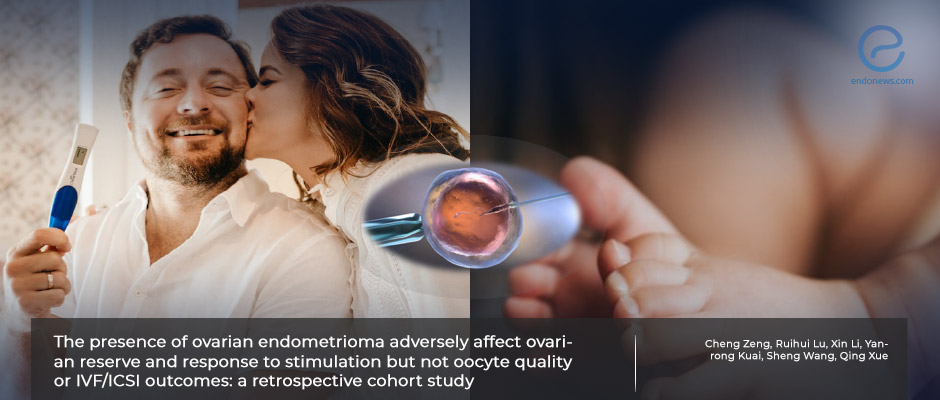Ovarian endometriomas, ovarian reserve, oocyte quality and IVF/ICSI outcomes
Dec 23, 2022
Cumulative live birth rates remain similar in women with endometriomas compared to controls.
Key Points
Importance:
- Ovaries with endometrioma may have lower antral follicle count, but have a similar number of oocytes with healthy contralateral ovaries.
Highlights:
- Ovarian endometrioma size and surgery may adversely affect ovarian reserve but not cumulative live birth rates.
What's done here:
- A Chinese team conducted a retrospective cohort study to assess ovarian endometriomas on IVF cycles.
- The data of 154 infertile women who had ovarian endometriomas were compared to 305 women without endometriomas.
- The ovarian reserve, response to stimulation, embryo quality, and pregnancy outcomes were evaluated in all patients who underwent their first IVF/ICSI cycles.
Key results:
- After matching body mass index, maternal age, and infertility duration, 305 women remained in the control cohort.
- Ovarian endometriomas significantly reduced ovarian reserve markers (AMH and AFC), the number of oocytes, embryos, and top-quality embryos, especially if their size was more than 6 cm.
- However, the cumulative live birth rates were comparable between the study and control groups, regardless of the previous history of ovarian surgery.
- Ovaries with endometrioma had a significantly lower antral follicle count, but a similar number of oocytes compared to healthy contralateral ovaries.
Strengths and limitations:
- The evaluation of potential confounders and selection bias while group matching, and performing a wide range of comparisons during statistical analyzes are strengths.
- The limitation is the possibility of the presence of endometriosis in the control group..
Lay Summary
Surgery and assisted reproductive technology (ART) are the preferred treatments for endometrioma in infertile patients. When ART is considered, surgery may seem to have no advantages, as it may not improve pregnancy outcomes and may carry the risk of decreasing ovarian reserve. Therefore for infertility specialists, ART becomes the first choice for infertile women with ovarian endometrioma. ART could be applied to women whose ovarian reserve is compromised and/or who are over 35 years of age with endometriomas below 40 mm in diameter.
Dr. Zeng et al. from Peking University, Beijing, China, analyzed the ART cycles and pregnancy outcomes of 459 infertile women, 154 with endometrioma, and 305 without. The primary outcome was the cumulative live birth rate which was defined as the rate of live birth following the transfer of all (fresh or frozen-thawed ) embryos available from the stimulated cycle. Also, subgroup analyses were made to analyze the effect of ovarian surgery, cyst size, and laterality on the cumulative live birth rate.
The second outcome measures were AMH, antral follicle count, the number of oocytes retrieved, the maturity rate, fertilization rate, the number of embryos, the proportion of top-quality embryos, the balance of transplantable embryos, the number of frozen embryos, the implantation rate, the clinical pregnancy rate, and the live birth rate.
The results indicate that the ovarian reserve and the response to stimulation after IVF/ICSI were significantly lower in patients with endometriomas compared with non-endometriosis controls after adjusting age, BMI, and infertility duration. But clinical pregnancy outcomes, especially live birth and clinical pregnancy rates, did not differ significantly between the two groups.
" More extensive prospective studies are still needed to evaluate whether the presence or the increasing size of endometrioma associated with a worse pregnancy outcome," concluded the authors in their recently published article in the "Journal of Ovarian Research".
Research Source: https://pubmed.ncbi.nlm.nih.gov/36273148/
endometrioma assisted reproductive techniques InVitroFertilization Intra Cytoplasmic Sperm Injection oocyte pickup embriyo transfer cumulative live birth rate endometriosis.

